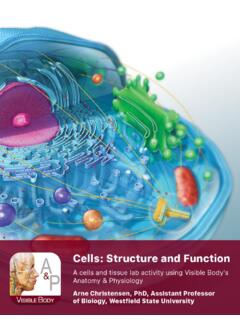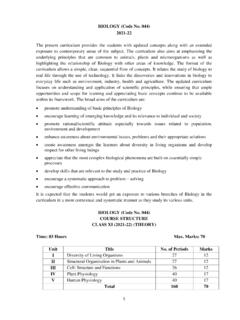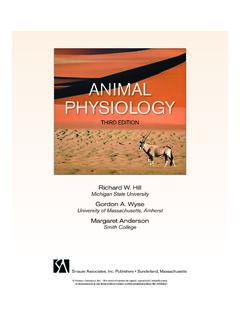Transcription of CHAPTER 17 B E G - NCERT
1 268 BIOLOGYAs you have read earlier, oxygen (O2) is utilised by the organisms toindirectly break down simple molecules like glucose, amino acids, fattyacids, etc., to derive energy to perform various activities. Carbon dioxide(CO2) which is harmful is also released during the above catabolicreactions. It is, therefore, evident that O2 has to be continuously providedto the cells and CO2 produced by the cells have to be released out. Thisprocess of exchange of O2 from the atmosphere with CO2 produced by thecells is called breathing, commonly known as respiration . Place yourhands on your chest; you can feel the chest moving up and down. Youknow that it is due to breathing. How do we breathe? The respiratoryorgans and the mechanism of breathing are described in the followingsections of this ORGANSM echanisms of breathing vary among different groups of animalsdepending mainly on their habitats and levels of organisation.
2 Lowerinvertebrates like sponges, coelenterates, flatworms, etc., exchange O2with CO2 by simple diffusion over their entire body surface. Earthwormsuse their moist cuticle and insects have a network of tubes (trachealtubes) to transport atmospheric air within the body. Special vascularisedstructures called gills (branchial respiration ) are used by most of theaquatic arthropods and molluscs whereas vascularised bags called lungs(pulmonary respiration ) are used by the terrestrial forms for the exchangeof gases. Among vertebrates, fishes use gills whereas amphibians, reptiles,birds and mammals respire through lungs. Amphibians like frogs canrespire through their moist skin (cutaneous respiration ) AND EXCHANGE OF GASESCHAPTER ofRespiratorySystem2021-22269 BREATHING AND EXCHANGE OF Respiratory SystemWe have a pair of external nostrils opening out above the upper leads to a nasal chamber through the nasal passage.
3 The nasalchamber opens into the pharynx, a portion of which is the commonpassage for food and air. The pharynx opens through the larynx regioninto the trachea. Larynx is a cartilaginous box which helps in soundproduction and hence called the sound box. During swallowing glottiscan be covered by a thin elastic cartilaginous flap called epiglottis toprevent the entry of food into the larynx. Trachea is a straight tubeextending up to the mid-thoracic cavity, which divides at the level of5th thoracic vertebra into a right and left primary bronchi. Each bronchiundergoes repeated divisions to form the secondary and tertiary bronchiand bronchioles ending up in very thin terminal bronchioles. Thetracheae, primary, secondary and tertiary bronchi, and initialbronchioles are supported by incomplete cartilaginous rings.
4 Eachterminal bronchiole gives rise to a number of very thin, irregular-walledand vascularised bag-like structures called alveoli. The branchingnetwork of bronchi, bronchioles and alveoli comprise the lungs ( ). We have two lungs which are covered by a double layered pleura,with pleural fluid between them. It reduces friction on the outer pleural membrane is in close contact with the thoracicBronchusLungheartDiaphragmEpiglo ttisLarynxTracheaCut end of ribPleural membranesAlveoliPleural fluidBronchioleFigure view of human respiratory system (sectional view ofthe left lung is also shown)2021-22270 BIOLOGY lining whereas the inner pleural membrane is in contact with the lungsurface. The part starting with the external nostrils up to the terminalbronchioles constitute the conducting part whereas the alveoli and theirducts form the respiratory or exchange part of the respiratory conducting part transports the atmospheric air to the alveoli, clearsit from foreign particles, humidifies and also brings the air to bodytemperature.
5 Exchange part is the site of actual diffusion of O2 and CO2between blood and atmospheric lungs are situated in the thoracic chamber which is anatomicallyan air-tight chamber. The thoracic chamber is formed dorsally by thevertebral column, ventrally by the sternum, laterally by the ribs and onthe lower side by the dome-shaped diaphragm. The anatomical setup oflungs in thorax is such that any change in the volume of the thoraciccavity will be reflected in the lung (pulmonary) cavity. Such anarrangement is essential for breathing, as we cannot directly alter thepulmonary involves the following steps:(i)Breathing or pulmonary ventilation by which atmospheric airis drawn in and CO2 rich alveolar air is released out.(ii)Diffusion of gases (O2 and CO2) across alveolar membrane.
6 (iii)Transport of gases by the blood.(iv)Diffusion of O2 and CO2 between blood and tissues.(v)Utilisation of O2 by the cells for catabolic reactions and resultantrelease of CO2 ( cellular respiration as dealt in the CHAPTER 14). OF BREATHINGB reathing involves two stages : inspiration during which atmosphericair is drawn in and expiration by which the alveolar air is released movement of air into and out of the lungs is carried out by creating apressure gradient between the lungs and the atmosphere. Inspirationcan occur if the pressure within the lungs (intra-pulmonary pressure) isless than the atmospheric pressure, , there is a negative pressure inthe lungs with respect to atmospheric pressure. Similarly, expiration takesplace when the intra-pulmonary pressure is higher than the atmosphericpressure.
7 The diaphragm and a specialised set of muscles external andinternal intercostals between the ribs, help in generation of such is initiated by the contraction of diaphragm which increasesthe volume of thoracic chamber in the antero-posterior axis. Thecontraction of external inter-costal muscles lifts up the ribs and the2021-22271 BREATHING AND EXCHANGE OF GASES sternum causing an increase in the volume ofthe thoracic chamber in the dorso-ventral overall increase in the thoracic volumecauses a similar increase in pulmonaryvolume. An increase in pulmonary volumedecreases the intra-pulmonary pressure to lessthan the atmospheric pressure which forcesthe air from outside to move into the lungs, , inspiration (Figure ). Relaxation ofthe diaphragm and the inter-costal musclesreturns the diaphragm and sternum to theirnormal positions and reduce the thoracicvolume and thereby the pulmonary leads to an increase in intra-pulmonarypressure to slightly above the atmosphericpressure causing the expulsion of air from thelungs, , expiration (Figure ).
8 We havethe ability to increase the strength ofinspiration and expiration with the help ofadditional muscles in the abdomen. On anaverage, a healthy human breathes 12-16times/minute. The volume of air involved inbreathing movements can be estimated byusing a spirometer which helps in clinicalassessment of pulmonary Volumes andCapacitiesTidal Volume (TV): Volume of air inspired orexpired during a normal respiration . It isapprox. 500 mL., , a healthy man caninspire or expire approximately 6000 to 8000mL of air per Reserve Volume (IRV):Additional volume of air, a person can inspireby a forcible inspiration. This averages 2500mL to 3000 Reserve Volume (ERV):Additional volume of air, a person can expireby a forcible expiration.
9 This averages 1000mL to 1100 Mechanism of breathing showing :(a) inspiration (b) expiration2021-22272 BIOLOGYR esidual Volume (RV): Volume of air remaining in the lungs even after aforcible expiration. This averages 1100 mL to 1200 adding up a few respiratory volumes described above, one canderive various pulmonary capacities, which can be used in Capacity (IC): Total volume of air a person can inspireafter a normal expiration. This includes tidal volume and inspiratoryreserve volume (TV+IRV).Expiratory Capacity (EC): Total volume of air a person can expire aftera normal inspiration. This includes tidal volume and expiratory reservevolume (TV+ERV).Functional Residual Capacity (FRC): Volume of air that will remain inthe lungs after a normal expiration.
10 This includes ERV+ Capacity (VC): The maximum volume of air a person can breathe inafter a forced expiration. This includes ERV, TV and IRV or the maximumvolume of air a person can breathe out after a forced Lung Capacity (TLC): Total volume of air accommodated in thelungs at the end of a forced inspiration. This includes RV, ERV, TV andIRV or vital capacity + residual OF GASESA lveoli are the primary sites of exchange of gases. Exchange of gases alsooccur between blood and tissues. O2 and CO2 are exchanged in thesesites by simple diffusion mainly based on pressure/concentrationgradient. Solubility of the gases as well as the thickness of the membranesinvolved in diffusion are also some important factors that can affect therate of contributed by an individual gas in a mixture of gases iscalled partial pressure and is represented as pO2 for oxygen and pCO2 forcarbon dioxide.














